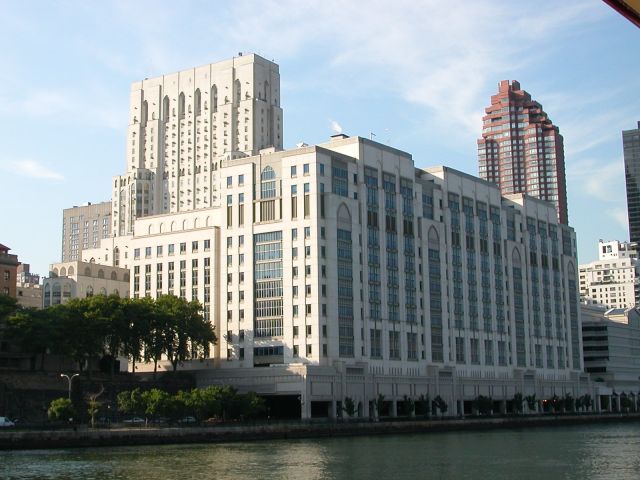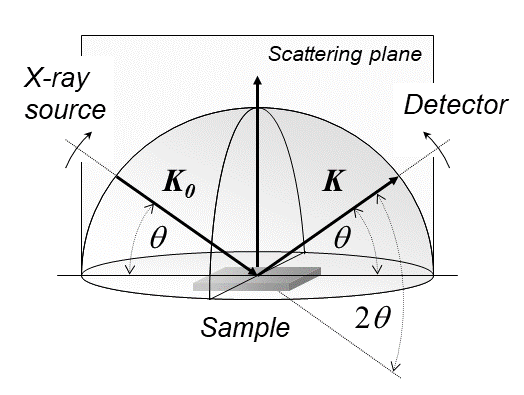|
Energy-dispersive X-ray Diffraction
Energy-dispersive X-ray diffraction (EDXRD) is an analytical technique for characterizing materials. It differs from conventional X-ray diffraction by using polychromatic photons as the source and is usually operated at a fixed angle. With no need for a goniometer, EDXRD is able to collect full diffraction patterns very quickly. EDXRD is almost exclusively used with synchrotron radiation which allows for measurement within real engineering materials. History EDXRD was originally proposed independently by Buras et al. and Giessen and Gordon in 1968. Advantages The advantages of EDXRD are (1) it uses a fixed scattering angle, (2) it works directly in reciprocal space, (3) fast collection time, and (4) parallel data collection. The fixed scattering angle geometry makes EDXRD especially suitable for in situ studies in special environments (e.g. under very low or high temperatures and pressures). When the EDXRD method is used, only one entrance and one exit window are needed. Th ... [...More Info...] [...Related Items...] OR: [Wikipedia] [Google] [Baidu] |
Helmholtz Association
The Helmholtz Association of German Research Centres () is the largest scientific organisation in Germany. It is a union of 18 scientific-technical and biological-medical research centers. The official mission of the Association is "solving the grand challenges of science, society and industry". Scientists at Helmholtz therefore focus research on complex systems which affect human life and the environment. The namesake of the association is the German physiologist and physicist Hermann von Helmholtz.Helmholtz Association – About Us retrieved 24-May-2012. The annual budget of the Helmholtz Association amounts to €5.8 billion, of which about 70% is raised from public funds. The remaining 30% of the budget is acquired by the 19 individual Helmholtz Centres in the form of contract funding. The public funds are provided by ... [...More Info...] [...Related Items...] OR: [Wikipedia] [Google] [Baidu] |
X-ray Crystallography
X-ray crystallography is the experimental science of determining the atomic and molecular structure of a crystal, in which the crystalline structure causes a beam of incident X-rays to Diffraction, diffract in specific directions. By measuring the angles and intensities of the X-ray diffraction, a crystallography, crystallographer can produce a three-dimensional picture of the density of electrons within the crystal and the positions of the atoms, as well as their chemical bonds, crystallographic disorder, and other information. X-ray crystallography has been fundamental in the development of many scientific fields. In its first decades of use, this method determined the size of atoms, the lengths and types of chemical bonds, and the atomic-scale differences between various materials, especially minerals and alloys. The method has also revealed the structure and function of many biological molecules, including vitamins, drugs, proteins and nucleic acids such as DNA. X-ray crystall ... [...More Info...] [...Related Items...] OR: [Wikipedia] [Google] [Baidu] |
Indus 2
Indus-2 is a synchrotron radiation source with a nominal electron energy of 2.5 GeV and a critical wavelength of about 1.98 angstroms. It is one of the most important projects in progress at the Raja Ramanna Centre for Advanced Technology. It is designed to cater to the needs of X-ray users, material scientists and researchers. Indus-1 has the distinction of being the first synchrotron generator of India with a 450 Mev storage ring. Indus-2 is an improvement over Indus-1. Indus-2 lattice has been designed in such a way as to give low beam emittance and high brightness. The lattice is a Double Bend Acromat with zero dispersion function along the long straight section. It has eight super periods each having two dipole bending magnets, four focusing and five defocusing quadrupoles and six sextupoles. Of the eight long straight section, three will be used for injection and RF cavities respectively. The remaining five will be used for insertion devices. The radiation source ... [...More Info...] [...Related Items...] OR: [Wikipedia] [Google] [Baidu] |
SOLEIL
SOLEIL ("Sun" in French) is a synchrotron facility near Paris, France. It performed its first acceleration of electrons on May 14, 2006. The name ''SOLEIL'' is a backronym for ''Source Optimisée de Lumière d’Énergie Intermédiaire du LURE'' (LURE optimised intermediary energy light source), LURE meaning ''Laboratoire pour l'Utilisation du Rayonnement Électromagnétique''. The facility is run by a civil corporation held by the French National Centre for Scientific Research (CNRS) and the French Alternative Energies and Atomic Energy Commission (CEA), two French national research agencies. It is located in Saint-Aubin in the Essonne département, a south-western suburb of Paris, near Gif-sur-Yvette and Saclay, which host other facilities for nuclear and particle physics. The facility is an associate member of the University of Paris-Saclay. SOLEIL also hostIPANEMA, the European research platform on ancient materials (archaeology, palaeontology, past environments and cultur ... [...More Info...] [...Related Items...] OR: [Wikipedia] [Google] [Baidu] |
Diamond Light Source
Diamond Light Source (or Diamond) is the UK's national synchrotron light source science facility located at the Harwell Science and Innovation Campus in Oxfordshire. Its purpose is to produce synchrotron light, intense beams of light whose special characteristics are useful in many areas of scientific research. In particular it can be used to investigate the structure and properties of a wide range of materials from proteins (to provide information for designing new and better drugs), and engineering components (such as a fan blade from an aero-engine) to conservation of archeological artifacts (for example Henry VIII's flagship the Mary Rose). There are more than 50 light sources across the world. With an energy of 3 GeV, Diamond is a medium energy synchrotron currently operating with 32 Beamline#Synchrotron radiation beamline, beamlines. Design, construction and finance The Diamond synchrotron is the largest UK-funded scientific facility to be built in the UK since th ... [...More Info...] [...Related Items...] OR: [Wikipedia] [Google] [Baidu] |
Cornell University
Cornell University is a Private university, private Ivy League research university based in Ithaca, New York, United States. The university was co-founded by American philanthropist Ezra Cornell and historian and educator Andrew Dickson White in 1865. Since its founding, Cornell University has been a Mixed-sex education, co-educational and nonsectarian institution. As of fall 2024, the student body included 16,128 undergraduate and 10,665 graduate students from all 50 U.S. states and 130 countries. The university is organized into eight Undergraduate education, undergraduate colleges and seven Postgraduate education, graduate divisions on its main Ithaca campus. Each college and academic division has near autonomy in defining its respective admission standards and academic curriculum. In addition to its primary campus in Ithaca, Cornell University administers three satellite campuses, including two in New York City, the Weill Cornell Medicine, medical school and ... [...More Info...] [...Related Items...] OR: [Wikipedia] [Google] [Baidu] |
Cornell High Energy Synchrotron Source
Cornell University is a private Ivy League research university based in Ithaca, New York, United States. The university was co-founded by American philanthropist Ezra Cornell and historian and educator Andrew Dickson White in 1865. Since its founding, Cornell University has been a co-educational and nonsectarian institution. As of fall 2024, the student body included 16,128 undergraduate and 10,665 graduate students from all 50 U.S. states and 130 countries. The university is organized into eight undergraduate colleges and seven graduate divisions on its main Ithaca campus. Each college and academic division has near autonomy in defining its respective admission standards and academic curriculum. In addition to its primary campus in Ithaca, Cornell University administers three satellite campuses, including two in New York City, the medical school and Cornell Tech, and a branch of the medical school in Al Rayyan, Qatar's Education City. Cornell is one of three ... [...More Info...] [...Related Items...] OR: [Wikipedia] [Google] [Baidu] |
German Electron Synchrotron
DESY, short for Deutsches Elektronen-Synchrotron (English: ''German Electron Synchrotron''), is a national research centre for fundamental science located in Hamburg and Zeuthen near Berlin in Germany. It operates particle accelerators used to investigate the structure, dynamics and function of matter, and conducts a broad spectrum of interdisciplinary scientific research in four main areas: particle and high energy physics; photon science; astroparticle physics; and the development, construction and operation of particle accelerators. Its name refers to its first project, an electron synchrotron. DESY is publicly financed by the Federal Republic of Germany and the Federal States of Hamburg and Brandenburg and is a member of the Helmholtz Association. Functions and mission DESY's function is to conduct fundamental research for solely civil and peaceful purposes. It specialises in particle accelerator development, construction and operation, particle physics, astroparticle phy ... [...More Info...] [...Related Items...] OR: [Wikipedia] [Google] [Baidu] |
X-ray Diffraction
X-ray diffraction is a generic term for phenomena associated with changes in the direction of X-ray beams due to interactions with the electrons around atoms. It occurs due to elastic scattering, when there is no change in the energy of the waves. The resulting map of the directions of the X-rays far from the sample is called a diffraction pattern. It is different from X-ray crystallography which exploits X-ray diffraction to determine the arrangement of atoms in materials, and also has other components such as ways to map from experimental diffraction measurements to the positions of atoms. This article provides an overview of X-ray diffraction, starting with the early #History, history of x-rays and the discovery that they have the right spacings to be diffracted by crystals. In many cases these diffraction patterns can be #Introduction to x-ray diffraction theory, Interpreted using a single scattering or kinematical theory with conservation of energy (#Ewald's sphere, wave vecto ... [...More Info...] [...Related Items...] OR: [Wikipedia] [Google] [Baidu] |
Argonne National Laboratory
Argonne National Laboratory is a Federally funded research and development centers, federally funded research and development center in Lemont, Illinois, Lemont, Illinois, United States. Founded in 1946, the laboratory is owned by the United States Department of Energy and administered by UChicago Argonne LLC of the University of Chicago. The facility is the largest national laboratory in the Midwestern United States, Midwest. Argonne had its beginnings in the Metallurgical Laboratory of the University of Chicago, formed in part to carry out Enrico Fermi's work on nuclear reactors for the Manhattan Project during World War II. After the war, it was designated as the first national laboratory in the United States on July 1, 1946. In its first decades, the laboratory was a hub for peaceful use of nuclear physics; nearly all operating commercial nuclear power plants around the world have roots in Argonne research. More than 1,000 scientists conduct research at the laboratory, in the ... [...More Info...] [...Related Items...] OR: [Wikipedia] [Google] [Baidu] |
Advanced Photon Source
The Advanced Photon Source (APS) at Argonne National Laboratory (in Lemont, Illinois) is a storage-ring-based high-energy X-ray light source facility. It is one of five X-ray light sources owned and funded by the U.S. Department of Energy Office of Science. The APS began operation on March 26, 1995. It is operated as a user facility, meaning that it is open to the world’s scientific community, and more than 5,500 researchers make use of its resources each year. How APS works The APS uses a series of particle accelerators to push electrons up to nearly the speed of light, and then injects them into a storage ring that is roughly two-thirds of a mile around. At every bend in the track, these electrons emit synchrotron radiation in the form of ultrabright X-rays. Scientists at 65 experiment stations around the ring use these X-rays for basic and applied research in a number of fields. Scientists use the X-rays generated by the APS to peer inside batteries, with the goal of creati ... [...More Info...] [...Related Items...] OR: [Wikipedia] [Google] [Baidu] |






